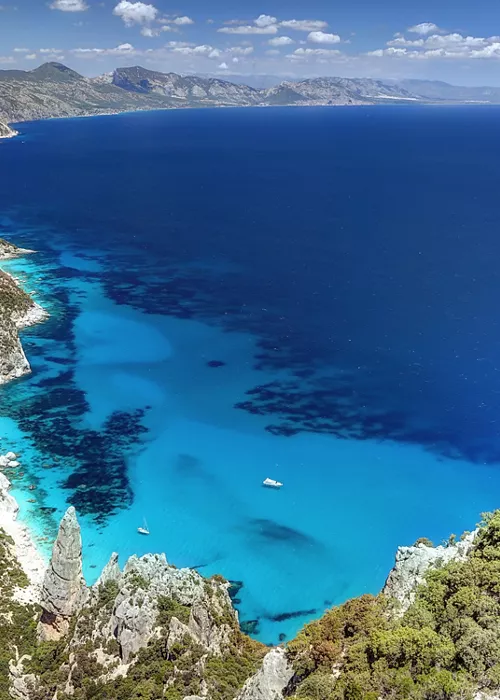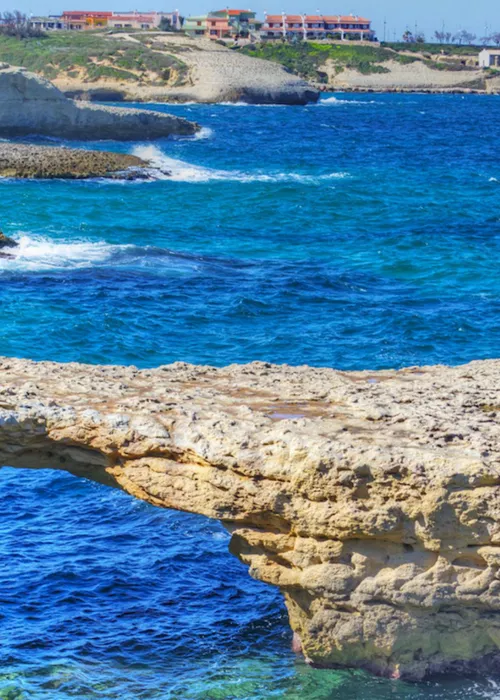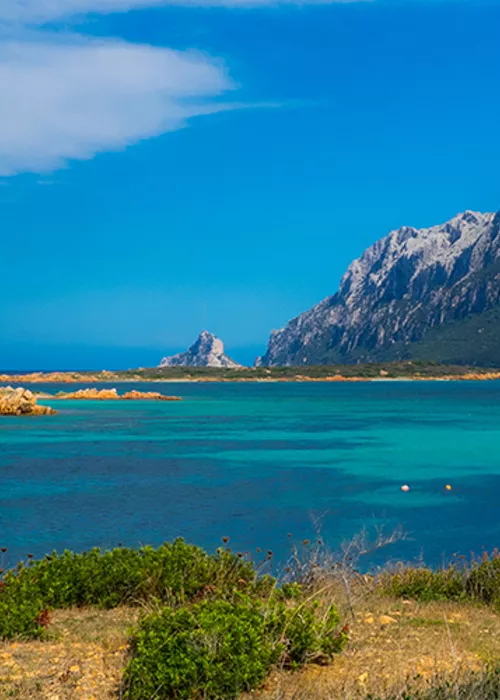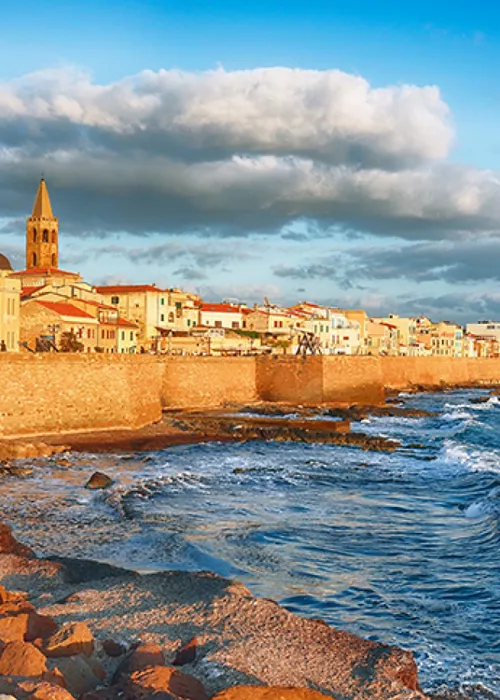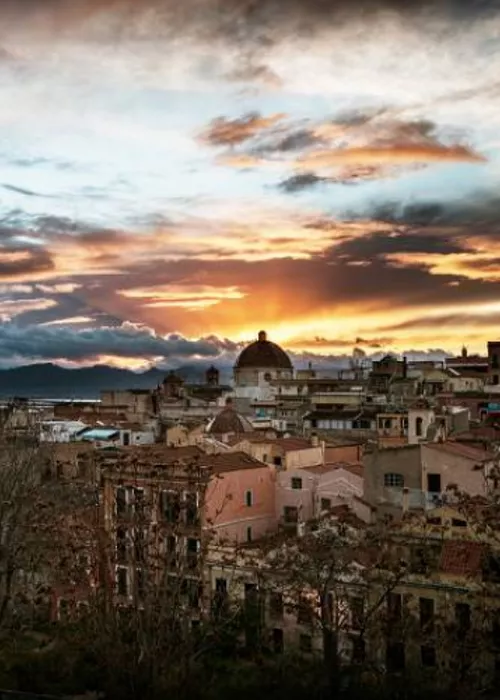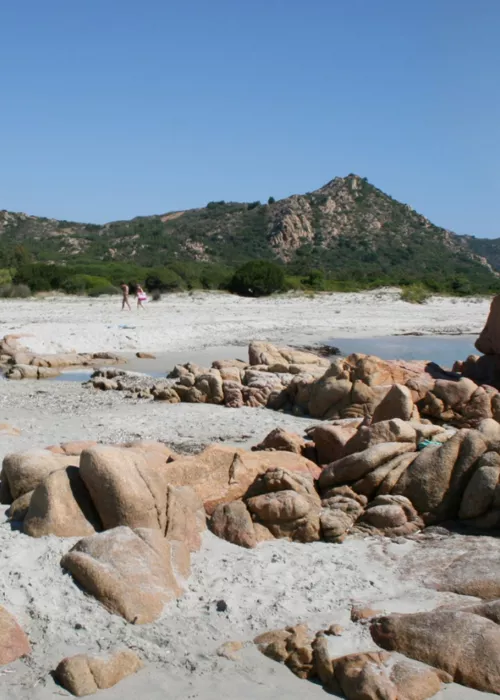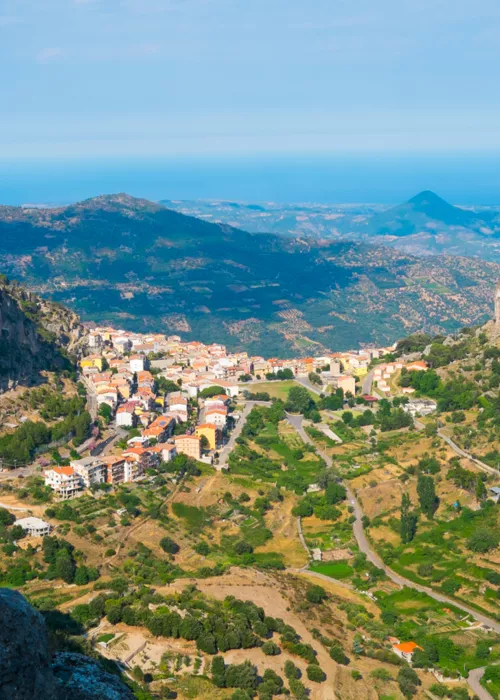San Vero Milis

San Vero Milis is an agricultural centre known for the art of weaving, with which reed baskets and baskets are made, the cultivation of mandarins and the production of Vernaccia. The town rises on the slopes of Montiferru and a short distance from the beautiful central-western coast of Sardinia, with the beach of Is Arenas, the Torre Su Puttu (Torre del Pozzo), a 17th-century Spanish tower, the quiet beach of Sa Capanna, and the striking S'Archittu, a natural arch carved into the limestone cliff. The parish church of St Sophia, dating from 1604, with a Gothic rose window in red trachyte and three Renaissance-style entrances, stands out in the village, while inside there are Baroque altars and simulacra.
Holy Week begins on Thursday, when the ceremony of the Mandatum, i.e. the washing of the feet of the apostles by Jesus, is renewed, as happens almost everywhere in Sardinia. "Is mazzettus", small bunches of mint, violets and other flowers, once blessed and the liturgical ceremony is over, are distributed to the faithful. The liturgy is preceded by the blessing of the Oils. This is followed in the following days by processions and the unhinging of Christ from the Cross, a moment of poignancy emphasised by songs. Until the Resurrection performance.
Milis

An ancient military outpost, Milis is surrounded by citrus groves that have given it the nickname 'land of oranges'. The 18th-century neoclassical Palazzo Boyl takes its name from the family whose summer residence it was and hosted illustrious figures such as Gabriele D'Annunzio, Grazia Deledda and Honoré De Balzac between the 19th and 20th centuries. Today it is a cultural centre with a picture gallery and the Museum of Sardinian Jewellery and Costume. There are two churches to see: S. Sebastiano, with a Catalan Gothic façade and an important rose window, and the church of S. Paolo, in Romanesque style, built in 1140-50 and completed, between 1200 and 1225, with the construction of the two-coloured wall face of the upper part of the façade in basalt ashlars, sandstone and green tuff.
In Milis, Holy Week begins with a robbery ('Sa Fura de Su Puddu') on the Sunday before Palm Sunday. A member of the confraternity of the Rosary, at around one o'clock in the afternoon, dressed in white and hooded, sneaks into the church of S. Vittoria to steal Su Puddu (a cross decorated with symbols of the Passion and surmounted by 'su puddu', or a rooster, belonging to the rival confraternity of the Holy Spirit) and takes it to the Chapel of the Rosary in the church of S. Sebastiano. An event that really happened in the 18th century then became a ritual in the village. On Maundy Thursday, Su Puddu is carried in procession from the confraternity of the Rosary to the church of S. Vittoria, where the crucified Christ is taken, then brought to the parish by the two confraternities. The popular rites continue on Good Friday with 'S'iscravamentu', the representation of the removal of Christ from the cross, followed by the procession of the dead Christ towards the church of S. Vittoria, where Su Puddu will be deposited to be 'stolen' again the following year.
Bonarcado

A sleepy village, in which stands one of Sardinia's most popular and unusual pilgrimage destinations: the religious complex consisting of the Roman basilica of S. Maria and the sanctuary of Our Lady of Bonacatu.
The origins of the place of worship are remote: they date back to a Nuragic settlement on which a Roman thermal village was built, the remains of which were used to build the sanctuary, as can be seen in the mosaic-paved basin in the "arm" eastern arm of the church. Today's building is the result of several interventions and additions in later periods. Such as the two façades, one Romanesque to the west (1242-1268), with hanging arches and multicoloured ceramic bowls, and one to the north (1933), in Neo-Romanesque style. The interior has a cross-shaped floor plan, with Greek cross arms and barrel vaults and Byzantine-inspired domes in the intersection. On the high altar is the polychrome terracotta bas-relief depicting the Madonna and Child (15th century) from which derives the island's oldest Marian cult , which attracts thousands of worshippers every year, especially in September, during the celebration of the Virgin.
Bonarcado also fervently lives the rites of Holy Week, with the distribution of bunches of flowers to the faithful and the succession of moments of popular religiosity accompanied by songs.
Santu Lussurgiu

Santu Lussurgiu, arranged amphitheatrically in a volcanic cone between olive groves and chestnut groves, is a lively centre of craft activities such as carpet weaving and the production of boots and saddles for horses. It is no coincidence that during the last three days of Carnival, the reckless equestrian display of "Sa Carrela 'e nanti" (the road ahead) takes place along Via Roma, with riders hurling themselves through bends, narrow streets, small slits and a cheering crowd. In Piazza Mercato stands the Church of S. Maria degli Angeli: built in 1483, it preserves an 18th-century high altar and a wooden group of the Madonna of the Angels, a work dating from the late 16th and early 17th centuries. Not far away, in the oldest part of the village, stands the small church of S. Croce, originally consecrated to St Lussorio (1185).
In Santu Lussurgiu, one can also witness the strong devotion of the inhabitants during the Easter rites, particularly on Holy Tuesday, during the Way of the Cross of "su Nazarenu" (Jesus Christ), accompanied by Miserere and novena. There are four "Cunfrarìas" (confraternities) that organise the rituals: Santa Rughe is the oldest (from around 1580), Su Rosariu (from 1605), Su Carmene (from 1629), and Sos Sette Dolores (from 1734).
Along the road from Santu Lussurgiu up towards Cuglieri, it is worth making a diversion to San Leonardo de Siete Fuentes, a thermal resort in a beautiful park of holm oaks, elms and chestnut trees, with seven springs from which diuretic mineral waters flow. The site was inhabited in the Middle Ages and the small church of St Leonard is fascinating evidence of this.
Cuglieri

Before reaching Cuglieri, on the top of a hillock, you can see the remains of Casteddu Ezzu, a restored medieval fortress erected by the judges of Torres. On the mountain, bare surfaces and rocky peaks alternate with vast expanses of downy oaks and holm oaks, with large specimens of holly and yew. Originally Gurulis Nova, a Roman town from the 2nd century BC, Cuglieri lies amphitheatrically on a hill. At the top stands the majestic 17th-century basilica of S. Maria della Neve, built on an earlier 13th-century structure, while the town centre retains picturesque views of rustic houses, narrow streets and beautiful mansions.
Cuglieri also boasts the hamlet of Santa Caterina of Pittinuri, a tourist resort with a beautiful 16th-century tower and a golden sandy beach surrounded by clear limestone rocks, with caves and ravines. Beyond the town, it is worth heading towards the Cape Nieddu cliff from which, in winter and spring, one can admire the spectacular 40-metre drop of the waters of the Salighes stream directly into the sea.
In Cuglieri, the rites of Holy Week are organised by five Confraternities: of the Convent, Santa Croce, Carmel, San Giovanni and the Rosary. All the ceremonies, spread throughout the various churches, are accompanied by liturgical songs. Curious is the procession of Sas Chilcas, on Maundy Thursday, the search for Jesus through the streets of the village and in the churches where the Sepulchres were set up.
Bosa

From a distance, it looks like a rainbow of small houses clinging to a hill: Bosa is a pleasant little town with a medieval feel, crossed by the placid waters of the river Temo, on which fishing boats float. From above looms the scenic Malaspina (or Serravalle) castle , built between the 12th and 14th centuries, which, in addition to the walls, preserves a large tower and the church of Nostra Signora de Regnos Altos, with its important fresco cycle (14th century).
In the popular Sa Costa district, cobbled lanes and trachyte stairways intertwine, while a walk along Via del Carmine, once home to shopkeepers (Sas Tendas), leads to the tree-lined square overlooked by the beautiful Church of the Carmine. Other enchanting features of this small town are Corso Vittorio Emanuele, in the Sa Piatta district (the lower part of the city that unravels at river level): a refined urban space paved in basalt and cobblestones, flanked by tall eighteenth- and nineteenth-century houses.
Then the Cathedral of the Immaculate Conception, with its unmistakable dome, the Sas Conzas district, built at the end of the 18th century along the left bank of the river to house the artisan activity of leather tanning, is today a complex of industrial architecture that was declared a national monument in 1989: one of the disused production buildings, a fine example of industrial archaeology, has been turned into the Tanning Museum. Finally, the beautiful church of St Peter, an ancient cathedral of the diocese of Bosa, in the countryside just a few kilometres from the town.



